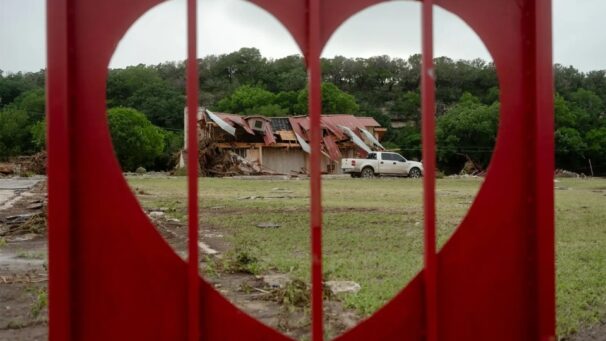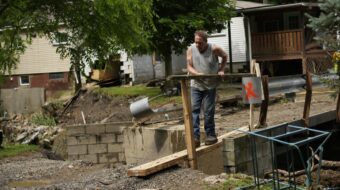
Editor’s Note: As the death toll from flash flooding in Texas Hill Country continues to rise, questions are swirling about the role that government inaction and past policy decisions may have contributed to the severity of the disaster.
Though he has now put the Federal Emergency Management Agency (FEMA) in charge of the response, for instance, abolishing the agency has been a top priority of President Donald Trump and his Homeland Security Secretary Kristi Noem. FEMA’s acting administrator was fired in May after telling the Republican-dominated Congress that he did not believe it was “in the best interest of the American people” to eliminate agency.
Furthermore, major Trump budget cuts at the National Oceanic and Atmospheric Administration (NOAA) have left several key positions vacant in weather forecasting offices, including the National Weather Service’s (NWS) office in Austin-San Antonio. The vacancies are the result of the early retirement pressure put on workers by Elon Musk and the Department of Government Efficiency (DOGE) in the early days of the second Trump administration.
In the article below, from The Texas Tribune reports on the refusal of legislators earlier this year to pass a funding bill to improve disaster response efforts in the state.
For the last three days, Texas State Rep. Wes Virdell has been out with first responders in Kerr County as they searched for victims and survivors from the devastating floods that swept through Central Texas early Friday morning.
“All the focus right now is let’s save all the lives we can,” Virdell, who was still on the scene in Kerrville, told The Texas Tribune on Sunday.
Virdell’s closeup view of the havoc wreaked on his district has made a lasting impression, he said, and left him reconsidering a vote he made just a few months ago against a bill that would have established a statewide plan to improve Texas’ disaster response, including better alert systems, along with a grant program for counties to buy new emergency communication equipment and build new infrastructure like radio towers.
“I can tell you in hindsight, watching what it takes to deal with a disaster like this, my vote would probably be different now,” said Virdell, a freshman GOP lawmaker from Brady.
The measure, House Bill 13, would have created a new government council to establish the emergency response plan and administer the grant program, both of which would have been aimed at facilitating better communication between first responders. The bill also called for the plan to include “the use of outdoor warning sirens,” like those used in tornado-prone Texas counties, and develop new “emergency alert systems.”

Authored by Rep. Ken King, R-Canadian, the legislation was inspired by last year’s devastating wildfires in the Panhandle, where more than 1 million acres burned—including part of King’s property—and three people died. The bill failed in the Texas Senate, prompting newfound questions about whether lawmakers should have done more to help rural, cash-strapped counties stave off the deadly effects of future natural disasters.
As of Monday morning, at least 82 people had died in the floods. Of those, most were in Kerr County, many of them camping or attending a private summer camp along the Guadalupe River.
Virdell, a Hill Country native who lives about 100 miles away, made his way to Kerrville early Friday after seeing news that rains raised the Guadalupe more than two feet, swamping its banks in Hunt and other river communities that host thousands of holiday vacationers.
He stressed an alarm system may not have helped much in this instance because the floodwaters came so quickly. Between 2 and 7 a.m., the Guadalupe River in Kerrville rose from 1 to more than 34 feet in height, according to a flood gauge in the area.
“I don’t think there was enough evidence to even suspect something like this was going to happen,” he said. “I think even if you had a warning system there, this came in so fast and early in the morning it’s very unlikely the warning system would have had much effect.”
Virdell said he doesn’t recall the specifics of the bill or why he opposed it, though he guessed “it had to do with how much funding” was tied to the measure.
Even if it had passed, it would not have gone into effect until Sept. 1, after the Hill Country flooding.
The bill’s initial $500 million cost drew heavy criticism from fellow Republicans including state Rep. Tony Tinderholt, R-Arlington.
“This shouldn’t be about anything other than the fact that it’s a half a billion dollars,” Tinderholt, a hardline conservative and budget hawk, said during the April 1 House floor debate. “This is probably one of the most simple votes we should be able to take today. It’s that this interoperability council is going to spend money to try and get these departments to be able to talk together.”
Steven Aranyi, a spokesperson for Lt. Gov. Dan Patrick, noted that lawmakers—including the Texas Senate, which Patrick oversees—made several “unprecedented” investments in disaster response during this year’s legislative session, totaling $547 million. That included:
- $257 million for disaster response aircraft,
- $135 million for regional operation facilities,
- $90 million to provide ambulances to rural counties,
- $65 million for emergency response drone technology.
The flaw with HB 13, Aranyi said, was that it proposed rolling out the local grant money over an estimated timeline of up to 10 years.
“By the time any system was developed, it would be outdated due to advances in technology,” Aranyi said. “The grants in the bill were limited to planning purposes only; they did not support disaster response.”
As the disaster quickly unfolded in Kerr County, located in the heart of an area known for flash floods, much has been made of the fact that the county lacked a siren system that counties in other parts of Texas have to alert residents of tornadoes. Such a system has been considered before in Kerr County but was quickly dismissed because the high cost would fall alone on local taxpayers.
A flash flood watch was issued by the National Weather Service by Thursday afternoon for the region. Then, in the middle of the night, at 1:14 a.m. Friday, a flash food warning was issued as possibly “catastrophic,” for Bandera and Kerr Counties, according to the NWS. Those alerts would have automatically triggered Wireless Emergency Alerts on enabled mobile devices, the weather service said.
But because the alerts went out when most residents and visitors were asleep, coupled with the fact that many of those children attending summer camp as well as their counselors were without cell phones, the alerts likely went unheeded by many.

Residents who were up before daylight on Friday, July 4, reported rain misting by 3 a.m. but nothing out of the ordinary. That changed quickly by 5 a.m. Friday, when flooding was detected on roadways in Kerr County.
The flooding reached its peak at around 6:45 a.m. in Kerrville, hours after warnings were first issued, according to the local flood gauge.
Kerr County Judge Rob Kelly told reporters on Saturday local residents have rejected the idea of a siren system due to its expense when it had been suggested before.
“The public reeled at the cost,” Kelly said.
At a news conference on Sunday, Gov. Greg Abbott left the door open to legislation aimed at improving emergency warning systems but stopped short of saying he would put it on the agenda for lawmakers to consider during the special session he has scheduled to begin July 21.
“It’s going to be something that will be looked at,” Abbott said. “The reality also is this, and that is, what’s needed in that river basin at that location could be far different than it was needed in some other river basin across the state.”
For now, Virdell said his focus and that of officials in Kerr County is on locating more victims and helping residents. He said the collaboration between local responders and those others coming in from around the state has been “amazing.”
Talk of warning systems and how to improve communications will eventually happen, Virdell said, adding that, right now, the focus needs to be on the immediate community.
“That’s the No. 1 priority for now,” he said.
This article is reposted from The Texas Tribune.
We hope you appreciated this article. At People’s World, we believe news and information should be free and accessible to all, but we need your help. Our journalism is free of corporate influence and paywalls because we are totally reader-supported. Only you, our readers and supporters, make this possible. If you enjoy reading People’s World and the stories we bring you, please support our work by donating or becoming a monthly sustainer today. Thank you!











